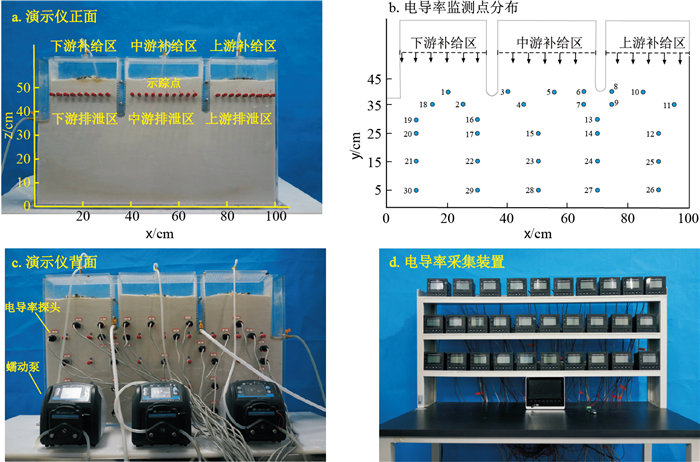| [1] |
Alley W M, Healy R W, LaBaugh J W, et al. Flow and storage in groundwater systems[J]. Science, 2002, 296: 1985-1990. doi: 10.1126/science.1067123
|
| [2] |
梁杏, 张婧玮, 蓝坤, 等. 江汉平原地下水化学特征及水流系统分析[J]. 地质科技通报, 2020, 39(1): 21-33. doi: 10.19509/j.cnki.dzkq.2020.0103Liang X, Zhang J W, Lan K, et al. Hydrochemical characteristics of groundwater and analysis of groundwater flow systems in Jianghan Plain[J]. Bulletin of Geological Science and Technology, 2020, 39(1): 21-33(in Chinese with English abstract). doi: 10.19509/j.cnki.dzkq.2020.0103
|
| [3] |
孙自永, 王俊友, 葛孟琰, 等. 基于水稳定同位素的地下水型陆地植被识别: 研究进展、面临挑战及未来研究展望[J]. 地质科技通报, 2020, 39(1): 11-20. doi: 10.19509/j.cnki.dzkq.2020.0102Sun Z Y, Wang J Y, Ge M Y, et al. Isotopic approaches to identify groundwater dependent terrestrial vegetation: Progress, challenges, and prospects for future research[J]. Bulletin of Geological Science and Technology, 2020, 39(1): 11-20(in Chinese with English abstract). doi: 10.19509/j.cnki.dzkq.2020.0102
|
| [4] |
江欣悦, 李静, 郭林, 等. 豫北平原浅层地下水化学特征与成因机制[J]. 地质科技通报, 2021, 40(5): 290-300. doi: 10.19509/j.cnki.dzkq.2021.0511Jiang X Y, Li J, Guo L, et al. Chemical characteristics and formation mechanism of shallow groundwater in the northern Henan Plain[J]. Bulletin of Geological Science and Technology, 2021, 40(5): 290-300(in Chinese with English abstract). doi: 10.19509/j.cnki.dzkq.2021.0511
|
| [5] |
Tóth J. A theoretical analysis of groundwater flow in small drainage basins[J]. Journal of Geophysical Research, 1963, 68(16): 4795-4812. doi: 10.1029/JZ068i016p04795
|
| [6] |
Haitiema H M, Sherry M B. Are water tables a subdued replica of the topography?[J]. Groundwater, 2005, 43(6): 781-786.
|
| [7] |
Gill B, Webb J, Stott K, et al. Economic, social and resource management factors influencing groundwater trade: Evidence from Victoria, Australia[J]. Journal of Hydrology, 2017, 550: 253-267. doi: 10.1016/j.jhydrol.2017.04.055
|
| [8] |
Gejl R N, Rygaard M, Henriksen H J, et al. Understanding the impacts of groundwater abstraction through long-term trends in water quality[J]. Water Research, 2019, 156: 241-251. doi: 10.1016/j.watres.2019.02.026
|
| [9] |
Shrestha S, Semkuyu D J, Pandey V P, et al. Assessment of groundwater vulnerability and risk to pollution in Kathmandu Valley, Nepal[J]. Science of the Total Environment, 2016, 556: 23-35. doi: 10.1016/j.scitotenv.2016.03.021
|
| [10] |
Zijl W, Mustafa E R. The evolution from an unsteady to a steady mixing zone between two groundwater flow systems with different concentrations[J]. Alexandria Engineering Journal, 2019, 58(2): 725-731. doi: 10.1016/j.aej.2019.06.003
|
| [11] |
蒋小伟, 万力, 王旭升, 等. 盆地地下水年龄空间分布规律[J]. 水文地质工程地质, 2012, 39(4): 1-6. https://www.cnki.com.cn/Article/CJFDTOTAL-SWDG201204003.htmJiang X W, Wan L, Wang X S, et al. Distribution of groundwater age in drainage basins[J]. Hydrogeology & Engineering Geology, 2012, 39(4): 1-6(in Chinese with English abstract). https://www.cnki.com.cn/Article/CJFDTOTAL-SWDG201204003.htm
|
| [12] |
王俊智. 盆地多级次地下水流系统识别方法研究[D]. 北京: 中国地质大学(北京), 2015.Wang J Z. A methodological study on the identification of hierarchically nested groundwater flow systems in drainage basins[D]. Beijing: China University of Geosciences(Beijing), 2015(in Chinese with English abstract).
|
| [13] |
Liang X, Liu Y, Jin M G, et al. Direct observation of complex Tóthian groundwater flow systems in the laboratory[J]. Hydrological Processes, 2010, 24(24): 3568-3573. doi: 10.1002/hyp.7758
|
| [14] |
梁杏, 牛宏, 张人权, 等. 盆地地下水流模式及其转化与控制因素[J]. 地球科学: 中国地质大学学报, 2012, 37(2): 269-275. https://www.cnki.com.cn/Article/CJFDTOTAL-DQKX201202011.htmLiang X, Niu H, Zhang R Q, et al. Basinal groundwater flow patterns and their transformation and dominant factors[J]. Earth Science: Journal of China University of Geosciences, 2012, 37(2): 269-275(in Chinese with English abstract). https://www.cnki.com.cn/Article/CJFDTOTAL-DQKX201202011.htm
|
| [15] |
Liang X, Quan D J, Jin M G, et al. Numerical simulation of groundwater flow patterns using flux as upper boundary[J]. Hydrological Processes, 2013, 27(24): 3475-3483. doi: 10.1002/hyp.9477
|
| [16] |
Wang J Z, Wörman A, Bresciani E, et al. On the use of late-time peaks of residence time distributions for the characterization of hierarchically nested groundwater flow systems[J]. Journal of Hydrology, 2016, 543: 47-58. doi: 10.1016/j.jhydrol.2016.04.034
|
| [17] |
Cardenas M B. Potential contribution of topography-driven regional groundwater flow to fractal stream chemistry: Residence time distribution analysis of Tóth flow[J]. Geophysical Research Letters, 2007, 34(5): 1-5.
|
| [18] |
Cardenas M B, Jiang X W. Groundwater flow, transport, and residence times through topography-driven basins with exponentially decreasing permeability and porosity[J]. Water Resources Research, 2010, 46(11): 1-9.
|





 下载:
下载:










